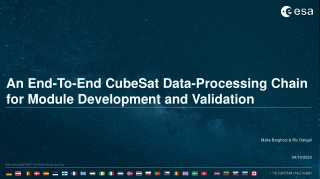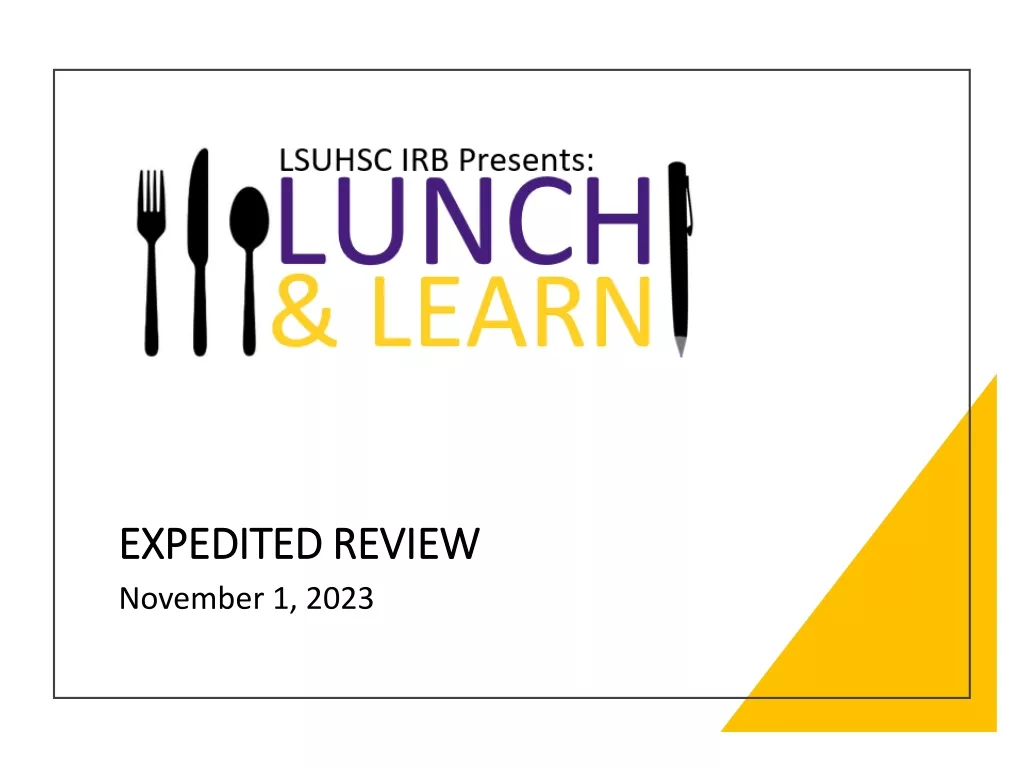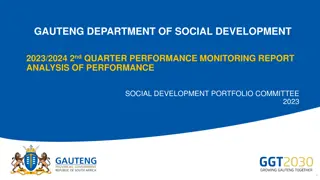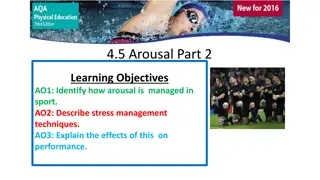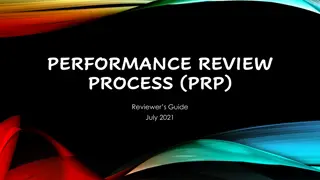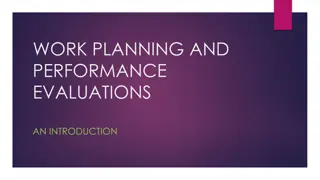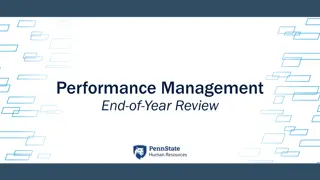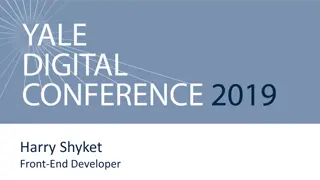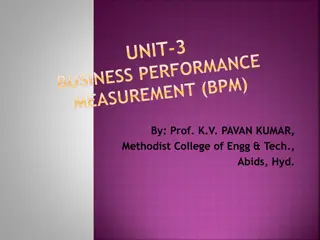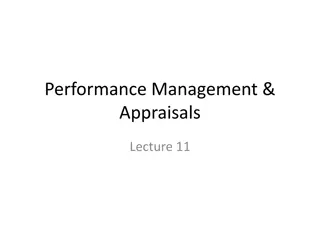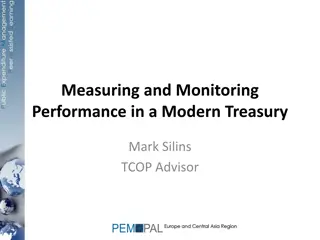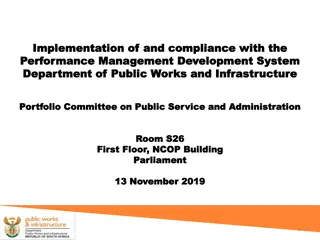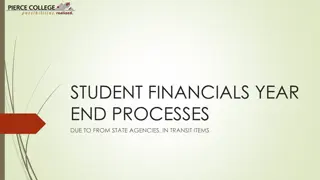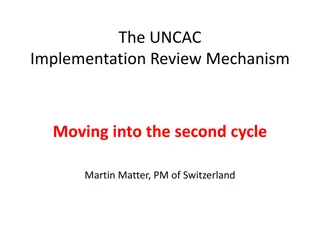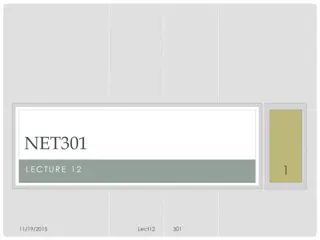Performance Management End-of-Year Review
Understand the process of performance management, setting expectations, goals, and feedback for staff development. Learn about the performance management cycle, including setting goals, mid-year check-ins, and end-of-year reviews. Prepare for the end-of-year review meeting by documenting employee performance, identifying growth opportunities, and aligning individual goals with department and university objectives.
Download Presentation

Please find below an Image/Link to download the presentation.
The content on the website is provided AS IS for your information and personal use only. It may not be sold, licensed, or shared on other websites without obtaining consent from the author.If you encounter any issues during the download, it is possible that the publisher has removed the file from their server.
You are allowed to download the files provided on this website for personal or commercial use, subject to the condition that they are used lawfully. All files are the property of their respective owners.
The content on the website is provided AS IS for your information and personal use only. It may not be sold, licensed, or shared on other websites without obtaining consent from the author.
E N D
Presentation Transcript
Performance Management End-of-Year Review
Housekeeping items Session is being recorded. Use the chat box to ask questions at any time. Please silence phones and minimize background noise. Inform your co-workers that you re attending this session. Please Note: If you are in a room with multiple people, please send a list of participants to Jen Clouser at jel33@psu.edu.
Today will help you to Prepare for the end-of-year review meeting Utilize Workday to document your employee s performance Identify your role and responsibilities in this process Identify opportunities for your employee s future growth and development
What is performance management? The process of setting expectations, aligning goals, assessing results, and focusing on staff development through ongoing conversations between managers and their direct report(s). Setting Expectations Setting Expectations Goals and Objectives Goals and Objectives Goal Alignment Goal Alignment The process of discussing what is expected from an employee in terms of job roles and responsibilities. Desired results each employee aims to achieve, based on conversations between managers and employees. Process of ensuring individual goals will support the achievement of department goals and department goals support the achievement of University goals. Feedback and Development Feedback and Development Feedback and Development Assessment Assessment Performance Calibration Performance Calibration Process in which supervisors at the same level in an organization discuss staff performance ratings and outcomes to ensure ratings and development messages are applied consistently across the University. Review of role, goals, and competencies by determining the level of successful achievement. Focus conversations between supervisors and employees in determining strengths, opportunities for improvement, and how to grow and develop.
Performance Management Cycle STEP ONE: STEP TWO: Mid-Year Check-In STEP THREE: End-of-Year Review Setting Goals & Expectations Ongoing Conversations between staff members and their supervisors throughout the year; Review goals and progress (make adjustments as needed). PREPARATION: PREPARATION: Staff member meets with manager to discuss expectations and set 2-5 goals for the performance management cycle. Staff member completes self-evaluation in Workday. Check-in: review expectations and acknowledgement of successes and challenges. Optional: staff member and manager obtain feedback from others (e.g., peers, customers, etc.) outside of Workday; primary manager can invite an additional manager to give feedback on the review via Workday. Staff member enters goals into Workday. Staff member and manager enter notes from the Mid-Year Check-In meeting into Workday. Staff member reviews Job Responsibility and makes updates, if applicable; manager reviews and approves JRW. Manager reviews and summarizes performance feedback for staff member in Workday. LEADERS LEADERS HR Strategic Partners provide leadership teams the performance results from the previous year. Peer managers conduct ratings calibration meetings (two levels). Leadership teams meet to discuss ratings and agree on norms; norms are shared with staff members during the goal setting process. DELIVERY: DELIVERY: Staff member meets with manager to discuss end- of-year review and receive an overall rating of their performance; acknowledgement of meeting occurs in Workday. Staff member and manager begin to discuss next year s goals and development opportunities. Recommended Timing: April 1 - May 31, 2019 Recommended Timing: June 1 August 31, 2018 Recommended Timing: November 1 - December 31, 2018
Program Components Content Area Focus Examples What do we need to accomplish this year in order to support my department s goals? Transition all budget records from old to new tracking system by March 31, 2019. Annual Goals Communication: Fosters open dialogue and actively listens to others in order to build and maintain effective and respectful working relationships throughout the University. What specific competencies and behaviors will help me accomplish my job responsibilities and achieve my goals for this year? Competencies & Behaviors I have read and understand the PSU Values and my obligations under AD88: Code of Responsible Conduct. Completion of compliance training such as: Annual Compliance Training (ACT), Building a Safe Penn State: Reporting Child Abuse Training, Clery Act Training (for CSAs), Understanding Title IX, Information Security Awareness, Etc. Values & Compliance AND I understand my compliance obligations and have completed the associate required compliance training(s) for my position.
Checklist Feedback from you as a Manager Receiving feedback as a staff member Do you provide clear expectations? Do you communicate your assessments? Do you hold back because of fear of staff member s response? Do you feel that feedback is a burden? Are your conversations thorough? Do you provide feedback promptly? How often do you ask for feedback? Do you ever get defensive? Do you ask for more detail? Are your conversations thorough? Do you ensure that expectations are clear? Do you set goals for improvement? Do you follow up to get additional feedback on progress?
Prior to writing the review Consider the following questions: Consider the following questions: What has the employee accomplished this year? Do those accomplishments meet the goals that were agreed upon? How is the employee utilizing each core competency? What is the employee doing that is highly effective? Is there anything getting in the way of their success? Overall has the employee been successful during the performance management cycle? If not, what can you do to help change this?
Vague vs Specific Vague: Vague: You do a great job running meetings. Specific: Specific: Everyone on the team appreciates the way you facilitate meetings. You identify the areas in which we have conflict, you summarize the points before we move on, and you maintain a positive environment for everyone to share and be heard. Vague: Vague: You re a terrible communicator. Specific: Specific: When you send out your monthly marketing plan updates/next steps, you tend to be too wordy and vague regarding next steps, which leaves your team confused with what they are being asked to do and what they will be held accountable for.
Tip: Use Reference Books
Ratings Scales Individual Components Rating Description Example Demonstrates and applies exceptional level of knowledge and skills. Consistently excels. Significant achievement relative to goals. Sets goal to cut department expenses by 10%, cuts by over 12%. Exceptional Contributor Demonstrates the appropriate level of knowledge and skills. Performs effectively and consistently. Achieves goals. Sets goal to cut department expenses by 10%, cuts by 8-12%. Successful Contributor Demonstrates a lack of knowledge and/or skills. Does not perform consistently. Does not achieve goals. Sets goal to cut department expenses by 10%, cuts by less than 8%. Needs Improvement Overall Evaluation Rating Description Example Consistently strong in the majority, if not all, individual evaluation components. Exceeds goals and job requirements; goes above and beyond to demonstrate behaviors. Consistently proficient in individual evaluation components; may be strong in several areas. Meets goals and job requirements; consistently demonstrates competencies & behaviors. Viewed as Exceptional on almost, if not all, goals, behaviors, and job responsibilities; Successful in remaining program components. Viewed as Successful on most goals, behaviors, and job responsibilities; may be Exceptional in several areas; may receive a few Needs Improvement ratings on individual goals/behaviors. Receives a Needs Improvement on a majority of goals, behaviors, and job responsibilities; may be Successful in a few areas. Exceptional Contributor Successful Contributor Needs improvement in most individual evaluation components. Does not meet goals and fails to satisfy job requirements; does not demonstrate competencies & behaviors. Needs Improvement
Completing the Overall Rating Is it realistic to give everyone on your team an Exceptional Contributor Contributor rating? Exceptional Exceptional Contributor Successful Contributor Needs Improvement Needs Improvement Successful Contributor Exceptional Contributor
Needs Improvement Rating Don t sugar-coat or avoid the bad news. This is your opportunity to address poor performance and correct poor attitude/behavior. You re not doing your employee any favors by being dishonest about the employee s performance.
Errors to Avoid Error Description Reviewing only the most recent performance and not taking into account events throughout the entire year. Recency Effect Allowing excellent performance in one area to overshadow the review of performance in other areas. Halo Effect (Lenience) Allowing unsatisfactory performance in one area to overshadow the review of performance in other areas. Horns Effect (Harshness) Selecting a middle or average rating to describe all performance; lack of differentiation among employees. Central Tendency Rating everyone low because of excessively high standards. Low Tolerance Rating everyone high in order to avoid conflict or hurt feelings. High Tolerance Making evaluations with incomplete information. Lack of Information Avoidance Reluctancy to discuss problem. Performance-rating error in which an employee s evaluation is biased either upward or downward because of comparison with another employee just previously evaluated. Contrast
Most Important Question How can I help you be more successful in your role? How can I help you be more successful in your role?
Manager End-of-Year Review Checklist & Utilizing Workday Review Checklist Launch Tutorial
To Do Encourage your employee(s) to attend a training session about preparing for their End-of-Year Review. Ask your employee(s) to complete their self-appraisals in Workday in a timely manner. Optional: Solicit feedback from a dotted line manager (in Workday) or others (outside of Workday regarding your employee s performance). Write the review(s) in Workday and arrive at an overall rating. Schedule time to meet with your employee(s) for their End-of-Year Review. Acknowledge in Workday that the end-of-year review conversation occurred and that the overall rating was shared with your employee(s).
Developing Your Employees As a manager it is important that you: 1. Support the growth and development of all employees within your department, regardless of role. 2. Are aware of each employee s strengths, developmental areas, and career goals. 3. Utilize the 70-20-10 approach for employee development 70% of development comes from on-the-job experience 20% of development comes from relationships, networking, observing others, etc. 10% of development comes from formal training opportunities.
Effective Performance Management Helps to: Helps to: Target critical talent for development and retention. Execute strategy by prioritizing and aligning goals and objectives. Improve performance of groups and individuals. Make better pay decisions based on performance and desired results. Identify top performers to develop a succession plan.
Jen Clouser Jen Clouser Human Resource Specialist Talent, Diversity, & Inclusion jel33@psu.edu


